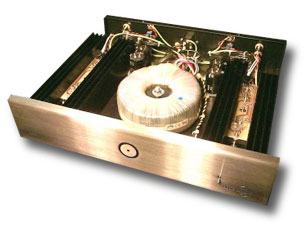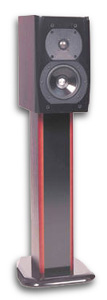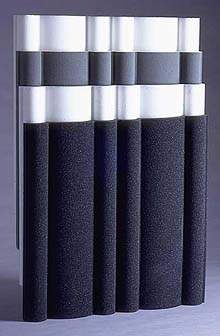![[SoundStage!]](../sslogo3.gif) Standout Systems Standout SystemsBack Issue Article |
| December 1999 Component Matching The system I now have running is truly a standout, although it came together a bit by accident and a bit by necessity. It all started when I received the Mirage MRM-1 loudspeakers for review ($2200 to $2500 per pair depending on finish, plus stands -- pricing for all products in this article in U.S. dollars). They’re a gorgeous little speaker with a thirst for a sufficient amount of power. No, we’re not talking hundreds of watts or anything of that sort, but the MRM-1s do want an amplifier that can deliver a bit of juice -- low-power tube amps need not apply. Given the plethora of high-powered amplifiers that adorn the market today, you can get good, high-quality solid-state power for a relatively low cost. But as I found out, it’s not always price that matters. Matching components is paramount. The power My long-term amplifier reference are the beautiful BC2 monoblocks from Blue Circle Audio ($6300 per pair). These large, wooden (yes, wooden) single-ended amps deliver 75Wpc at 8 ohms, which is more than enough for the vast majority of speakers I’ve had here. In fact, they sounded VERY good driving the MRM-1s. However, I noted that although I could get appreciable volume from the speakers, the amps started running out of steam and were likely approaching clipping. I surmised that I may need some more power to get the most out of the MRM-1s and tested my theory with the SimAudio HT-5 amplifier that I use in my home-theater system. The HT-5 is a stellar-sounding home-theater amplifier. In the case of the MRM-1, this amp took hold of them like a vice. It tightened and controlled the bass in a way the BC2 couldn’t quite muster. Since I have the MRM-1 under review and prefer to use a stereo amp for the evaluation, I phoned Gilbert Yeung at Blue Circle Audio and explained the situation. Lickety-split, he immediately sent down the company’s BC22 stereo amplifier ($2150).
Whether it’s the BC2 or BC22, both are driven by my BC3 Galatea line-stage preamplifier ($4650). It’s a wonderful preamplifier with minimalist features that puts out music, plain and simple. If you want a remote control, you’ll have to look elsewhere. If you’re like me and don’t mind getting up and click two knobs to increase or decrease the volume, then you’ll be happy. The speakers Don’t let the need for power sway you from
looking at the Mirage MRM-1. Their rated in-room efficiency is 85dB/W/m (about 82-83dB
anechoically). This beautifully built little minimonitor has an all-MDF cabinet lined internally with one-quarter-inch steel! The steel gives the cabinet an inert quality that a quick knuckle rap confirms. At some 35 pounds, this is a weighty little beast. The front baffle is black Corian, sculpted at the sides, which looks splendid. At the lower end of the price spectrum you get black ash finish for $2200 per pair. Up the price a few hundred dollars and you get what I have here -- tigerwood, which makes you go grrrr. If you want something in between, you can have cherry for $2300. The speakers have their own custom-made stands fabricated from Corian, MDF, steel and real-wood veneer trim that matches the speakers (prices are $500 for black ash and cherry, $600 for tigerwood). If you’re going to lay out the money for the speakers, get the stands too. I consider them an integral part, both visually and sonically. It’s a slick-looking and -sounding speaker system that has such niceties as high-quality binding posts, custom-made drivers from Mirage, and internal wiring from Cardas Audio. Mirage is proud of this speaker and each MRM-1 comes with an engraved nameplate on the back with the names of its designers -- Ian Paisley and Andrew Welker. The source and the other stuff After Marc Mickelson got through with the Bel Canto Design DAC1 ($1295), he mailed it to me to try out against my Theta Prime II. The DAC1 is a little rudimentary in terms of its ergonomics (I don’t like the connectors out either side, and I would like to see a power switch with an on/off light); however, whatever quibbles I have are obliterated when playing music. This is a fabulous-sounding DAC that may not be the best in the world, but I would wager it would give whatever is the best a real run for its money. I used my Theta Data Basic transport and Nirvana Audio Transmission Digital and T-2 digital cables. Although the digital components I used with the DAC1 will escalate the price quite a bit, Marc’s description of the DAC1 with Pioneer’s DV-414 DVD player as a transport (street price is less than $300) makes that combination sound like an outright steal for anyone seeking high-quality CD and DVD sound at an affordable price. For the rest of the cabling, I used Nirvana Audio S-L series speaker cable ($1095 for a two-meter pair) and S-L interconnect cable from the preamplifier to the amplifier ($695 for a one-meter pair). I’ve had these cables in my system for about two years and have no intention of selling or retiring them. Some people change cables like they change their underwear. I don’t feel that need (with cables, that is), and I’ve found these cables to be an ideal match for every loudspeaker and component I’ve brought in. For DAC to preamplifer, I used the new Nirvana Audio S-X cable ($1495 for a 1.5 meter pair). Now this is a pricey cable that only those with already outstanding systems should consider. Even Nirvana Audio recommends you don’t lay down the cash for more than the use of one pair in your system. The place it is to go is right at the source. Power conditioning is provided for all source components by a Power Wedge 114, and the amplifier is plugged into a Brick Wall series-mode surge suppressor specially designed for high-current amplifiers (I personally feel it mandatory to include serious power protection for high-quality components).
"Now Sing, Michael, Sing!" All tallied up, the system runs in excess of $10,000. Sound expensive? Well, if you factor in the depreciation of a new car once you drive the car off the lot (and what you could save if you squeezed one or two more years out of the buggy you have now), this amount of money in a music system that sounds this darn good could be considered an investment of sorts. Is the system missing anything? It’s a smooth and sweet-sounding combination with a lush, almost romantic quality and tight and well-controlled bass down to well below 50Hz, which is more than sufficient for most of us. What I get is big-system sound in a little room. The point here is really to consider all aspects when assembling your own system -- proper matching of components is crucial, as is the matching of the system to the room itself. This isn’t the type of system for a large room, but it’s ideal for small to medium-sized venues like mine. In fact, in rooms like these, you don’t want huge speakers anyway -- the best performance is likely attainable with a bookshelf monitor. While I don’t recommend you run out and buy a system exactly like this, I do recommend you look into some of these components while shopping. ...Doug Schneider
|
|
![[SoundStage!]](../sslogo3.gif) All Contents All ContentsCopyright © 1999 SoundStage! All Rights Reserved |
 Rated at 100Wpc at
8 ohms and 150Wpc into 4 ohms, the BC22 proved a better match than the BC2. Does this mean
that the BC22 is better than the BC2 for one-third the price? Well, yes and no. In a case
like this where power is important, the BC22 wins out because into both an 8-ohm and 4-ohm
load the amplifier can deliver more solid power. But in a case where the BC2 has no
trouble driving the speakers, the BC2 has a slightly sweeter top end, more liquidity and
bloom in the midrange, and deeper and more detailed bass. The BC22 images nicely, but the
BC2 casts a soundstage that’s wider and deeper with an infinite amount of detail. The
BC2s are that little bit better -- not necessarily three times better, but better in a way
that will have people with the means paying for what they do. However, the family
resemblance is apparent, and the BC22 is a great amplifier at a good price. For someone
who doesn’t have the cash for the BC2 (the vast majority of buyers) or doesn’t
want the heat the BC2s dissipate (and they do run very hot) or has speakers that need a
little more power (like the MRM-1s), then the BC22 is a great alternative. I must admit,
looking at the large BC2s against the elegant little BC22 had me scratching my head as to
what to do in my own system! Look for Jim Causey’s full review of this amp in a
future issue.
Rated at 100Wpc at
8 ohms and 150Wpc into 4 ohms, the BC22 proved a better match than the BC2. Does this mean
that the BC22 is better than the BC2 for one-third the price? Well, yes and no. In a case
like this where power is important, the BC22 wins out because into both an 8-ohm and 4-ohm
load the amplifier can deliver more solid power. But in a case where the BC2 has no
trouble driving the speakers, the BC2 has a slightly sweeter top end, more liquidity and
bloom in the midrange, and deeper and more detailed bass. The BC22 images nicely, but the
BC2 casts a soundstage that’s wider and deeper with an infinite amount of detail. The
BC2s are that little bit better -- not necessarily three times better, but better in a way
that will have people with the means paying for what they do. However, the family
resemblance is apparent, and the BC22 is a great amplifier at a good price. For someone
who doesn’t have the cash for the BC2 (the vast majority of buyers) or doesn’t
want the heat the BC2s dissipate (and they do run very hot) or has speakers that need a
little more power (like the MRM-1s), then the BC22 is a great alternative. I must admit,
looking at the large BC2s against the elegant little BC22 had me scratching my head as to
what to do in my own system! Look for Jim Causey’s full review of this amp in a
future issue. The impedance hovers between 5 and 8 ohms.
For very small speakers, this is somewhat par for the course, and it requires a little
more care in amplifier matching to get the speakers up to an appreciable volume.
Don’t think this requires exorbitant amounts of money to get there, though. For
example, I understand great results can be had with the SimAudio Celeste I-5080 integrated
amplifier ($1299). Obviously lots of other options exist too.
The impedance hovers between 5 and 8 ohms.
For very small speakers, this is somewhat par for the course, and it requires a little
more care in amplifier matching to get the speakers up to an appreciable volume.
Don’t think this requires exorbitant amounts of money to get there, though. For
example, I understand great results can be had with the SimAudio Celeste I-5080 integrated
amplifier ($1299). Obviously lots of other options exist too. People walk into my relatively
small room (about 11'W by 16'L by 8.5'H) and ask how I get such good sound from such a
small room, even with subwoofers in use. Speakers rarely overload my room, and bass is
always tight and well defined. The imaging I get is exemplary, and the depth of soundstage
is first-rate. OK, I'll quit bragging. The secret seems to be in the construction of the
walls, which are exceptionally rigid with concrete in some parts, and the wall treatment,
which is very cost effective. I use RPG ProFoam and Sonex (both available
from
People walk into my relatively
small room (about 11'W by 16'L by 8.5'H) and ask how I get such good sound from such a
small room, even with subwoofers in use. Speakers rarely overload my room, and bass is
always tight and well defined. The imaging I get is exemplary, and the depth of soundstage
is first-rate. OK, I'll quit bragging. The secret seems to be in the construction of the
walls, which are exceptionally rigid with concrete in some parts, and the wall treatment,
which is very cost effective. I use RPG ProFoam and Sonex (both available
from